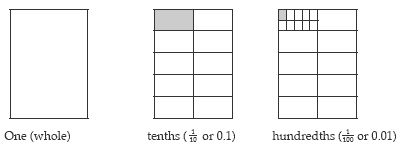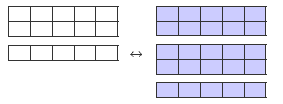Solve problems that involve adding and subtracting decimals.
Number Framework Stage 7
Using Materials
Introduce the students to the conventions of using decimats. You may like to use a context of chocolate blocks that will only break into a certain number of parts through dividing into ten equal parts, as follows:
Extend the system so that the students consider the size of one-tenth of a hundredth (one-thousandth) and one-tenth of a thousandth (one ten-thousandth).
Problem: “Lisa has 1.5 bars of cooking chocolate; Leon has 2.5 bars. How many bars do they have altogether?”
Get the students to perform the calculation, 1.5 + 2.5, on a calculator. Challenge them to explain why the answer is 4 and what has become of the decimal point. Use decimats to model the calculation. The decimat divided into tenths is ideal for this:
Both 0.5’s join to make another one. This gives four ones, which makes the decimal point redundant because there are no parts of one in the answer. Provide similar examples where longer decimals added together produce shorter decimals as answers. Get the students to model the operations with decimals.
Possible problems, in suitable story contexts, are:
2.3 + 2.7 = 5 1.25 + 1.75 = 3 0.26 + 1.74 = 2 0.375 + 0.125 = 0.5
The students can demonstrate their understanding of the number properties
involved by calculating and explaining the following problems:
2.31 + 1.99 = 4.3
0.348 + 1.652 = 2
1.0001 + 9.9999 = 11
0.3276 + 0.5724 = 0.9
0.333 + 0.333 + 0.001 = 1
The problems can be extended to subtraction where a decimal “so beautiful” is
made “ugly” by subtraction of another decimal. This may involve the students in
breaking up decimal place values, e.g., breaking fi ve ones into 4 ones and 10 tenths.
Some students might recognise that subtraction can be seen as difference. For
example, an easy way to solve 2 – 1.97 is to see the answer as the difference between two and one point nine seven. Both numbers can be made with decimats of different colours and 1.97 overlaid on top of 2.
Suitable problems are:
1 – 0.02 = 0.98
2.5 – 0.9 = 1.6
8 – 3.333 = 4.667
100 – 0.009 = 99.991
The students’ knowledge of fraction to decimal conversions will help in explainingthe answers, for example: 1.25 = 11/4 and 1.75 = 13/4, 1 1/4 + 1 3/4 = 3.
Using Imaging
Provide addition and subtraction problems that require the students to think about how decimal ones, tenths, hundredths, etc. are partitioned and/or recombined. Fold back to using decimats when the students have diffi culty either calculating or explaining the answer. Suitable problems, in story context, might be:
7.1 + 2.9 = 10 6.45 + 1.55 = 8 0.35 + 2.15 = 2.5 1.555 + 0.445 = 2
The students can demonstrate their understanding of the number propertiesinvolved by calculating and explaining the following problems:
2.31 + 1.99 = 4.3
0.348 + 1.652 = 2
1.0001 + 9.9999 = 11
0.3276 + 0.5724 = 0.9
0.333 + 0.333 + 0.001 = 1
The problems can be extended to subtraction where a decimal “so beautiful” is made “ugly” by subtraction of another decimal. This may involve the students in breaking up decimal place values, e.g., breaking fi ve ones into 4 ones and 10 tenths.
Some students might recognise that subtraction can be seen as difference. For example, an easy way to solve 2 – 1.97 is to see the answer as the difference between two and one point nine seven. Both numbers can be made with decimats of different colours and 1.97 overlaid on top of 2.
Suitable problems are:
1 – 0.02 = 0.98
2.5 – 0.9 = 1.6
8 – 3.333 = 4.667
100 – 0.009 = 99.991

